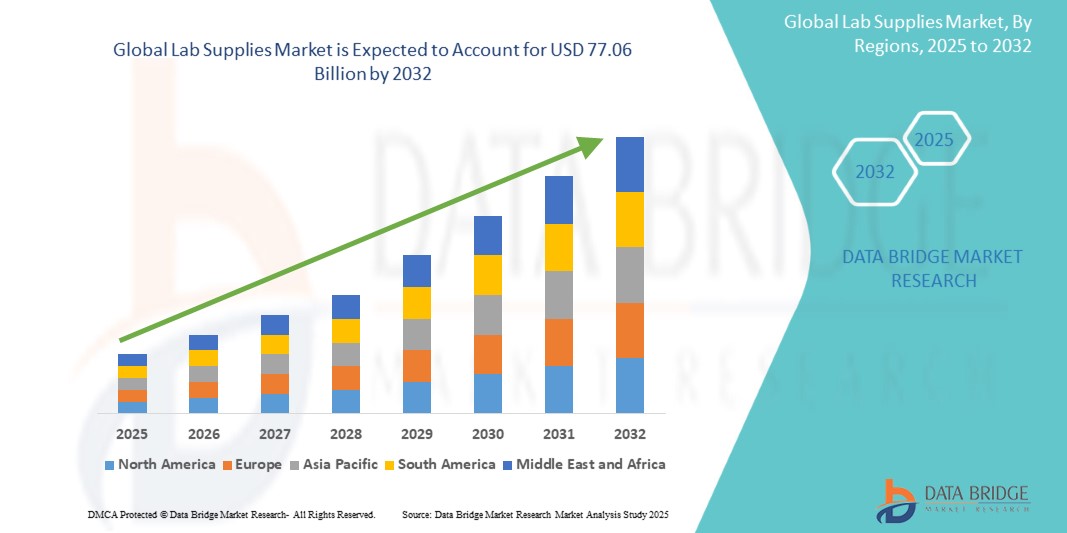The lab supplies market plays a critical role in supporting scientific research and development across various sectors, from pharmaceuticals and biotechnology to academia and industrial research. This post will delve into the market, exploring its size, share, opportunities, challenges, demand, and trends.
Market Size and Share
The lab supplies market is a substantial segment of the global scientific research industry. While precise figures can vary depending on data sources and regional factors, the market is estimated to be worth billions of dollars. Key players in the market include established scientific equipment manufacturers, chemical suppliers, and specialized laboratory product distributors.
Global lab supplies market size was valued at USD 41.63 billion in 2024 and is projected to reach USD 77.06 billion by 2032, with a CAGR of 8.0% during the forecast period of 2025 to 2032.
For more information, visit https://www.databridgemarketresearch.com/reports/global-lab-supplies-market
Market Opportunities
The lab supplies market presents several significant opportunities:
- Advancements in Life Sciences: Rapid advancements in life sciences, including genomics, proteomics, and cell biology, are driving demand for sophisticated lab supplies.
- Personalized Medicine: The growing focus on personalized medicine is creating demand for specialized reagents, kits, and instruments for genetic testing, biomarker analysis, and other personalized medicine applications.
- Drug Discovery and Development: The pharmaceutical and biotechnology industries rely heavily on advanced lab supplies for drug discovery, development, and manufacturing.
- Emerging Technologies: The emergence of new technologies, such as nanotechnology, artificial intelligence, and automation, is driving demand for specialized lab equipment and consumables.
- Emerging Markets: The growth of emerging economies is creating new demand for research infrastructure and laboratory supplies.
Market Challenges
Despite its growth potential, the lab supplies market faces several challenges:
- Price Pressure: Competitive pressures and cost containment measures in healthcare and research institutions can impact pricing and profitability.
- Regulatory Compliance: Adhering to stringent regulatory requirements related to product safety, quality, and performance can be complex and costly.
- Technological Advancements: Rapid technological advancements can quickly make existing products obsolete, requiring continuous innovation and investment in research and development.
- Supply Chain Disruptions: Disruptions in the supply chain, such as those caused by global events or natural disasters, can impact the availability and cost of lab supplies.
- Competition: The market is highly competitive, with numerous players offering a wide range of products and services.
Restraints/Challenges
The unstable pricing of raw materials will lead to high manufacturing costs, further impeding the market expansion for lab supplies. The lab supplies market growth rate will also be constrained by inconsistent rules and regulations along with unfavorable reimbursement practices in developing nations.
This lab supplies market report provides details of new recent developments, trade regulations, import-export analysis, production analysis, value chain optimization, market share, impact of domestic and localized market players, analyses opportunities in terms of emerging revenue pockets, changes in market regulations, strategic market growth analysis, market size, category market growths, application niches and dominance, product approvals, product launches, geographic expansions, technological innovations in the market. To gain more info on the lab supplies market contact Data Bridge Market Research for an Analyst Brief, our team will help you take an informed market decision to achieve market growth.
Market Demand
The demand for lab supplies is driven by several factors:
- Research and Development: The increasing investment in research and development activities across various sectors, including pharmaceuticals, biotechnology, academia, and industry, is driving demand for lab supplies.
- Technological Advancements: Advancements in scientific research and technology are driving the development of new and sophisticated lab equipment and consumables.
- Government Funding: Government funding for research and development initiatives is a major driver of demand for lab supplies.
- Healthcare Needs: The growing need for improved healthcare and the development of new treatments for diseases are driving demand for diagnostic and research tools.
- Environmental Monitoring: The increasing focus on environmental monitoring and protection is driving demand for laboratory equipment and supplies for environmental analysis.
Market Trends
Several key trends are shaping the lab supplies market:
- Automation and Robotics: The increasing adoption of automation and robotics in laboratories is driving demand for automated liquid handling systems, robotic sample preparation systems, and other automated equipment.
- Miniaturization: The development of miniaturized lab-on-a-chip devices and other microfluidic technologies is enabling faster, more efficient, and less expensive laboratory analyses.
- Digitalization: The integration of digital technologies, such as cloud computing and artificial intelligence, is improving data management, analysis, and interpretation in laboratories.
- Sustainability: The increasing emphasis on sustainability is driving demand for eco-friendly and sustainable lab supplies.
- Personalized Medicine: The growing focus on personalized medicine is driving demand for specialized reagents and kits for genetic testing, biomarker analysis, and other personalized medicine applications.
In conclusion, the lab supplies market is a dynamic and growing industry, driven by advancements in science and technology, increasing research and development activities, and the growing demand for personalized medicine. As the field of scientific research continues to evolve, the demand for high-quality and innovative lab supplies is expected to remain strong.



